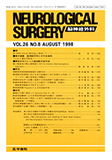Japanese
English
- 有料閲覧
- Abstract 文献概要
- 1ページ目 Look Inside
I.はじめに
確実に高齢化社会に向かっている日本では,非侵襲的なMRIの普及にともない,高齢者の未破裂脳動脈瘤(以下,未破裂瘤)症例が発見される機会が増加している.しかし,これら高齢者未破裂瘤症例の治療に関して一定の方針がないのが現状である.一般に未破裂瘤の手術的治療は70歳以下を対象とすることが多い18).しかし,今後,健康で日常生活動作の自立した高齢者人口が増加してくる状況において70歳という年齢で手術適応なしとすることには問題があると思われる.今回,70歳以上で発見された未破裂瘤の自験例を分析し,その治療方針につき検討する.
Long-term natural history of unruptured cerebral aneurysms is not found frequently. Hence, the indica-tions for surgery on unruptured asymptomatic cerebral aneurysms are still unclear. The benefit of treat-ment ultimately depends on the relative risk of subsequent aneurysm rupture in untreated patients versusthe risk involved in surgery.
Clinical features of fourteen elderly patients aged over 70 years with incidentally discovered unrupturedaneurysms were analyzed. Two were male and 12 were female, with ages ranging from 70 to 82 years(mean: 74.5 years). Aneurysms were located in the anterior circulation in 13 patients and in the posteriorcirculation in 1 patient. One patient had multiple aneurysms, that is, bilateral middle cerebral aneurysms.The size of all these aneurysms was less than 10 mm. The indication for surgery was determined case bycase. General information about the natural history of incidentally discovered aneurysms was given to thepatients and their relatives. Informed consent was based on the fact that subarachnoid hemorrhage wasassociated with a poor prognosis, while excellent operative results were common in patients with unrup-tured aneurysms. Five patients agreed to surgical treatment. Four of them, their ages being 70, 70, 72 and72 years old, with aneurysms located on the middle cerebral arteries, underwent neck clipping of theiraneurysms with no operative morbidity or mortality. However, the remaining one patient was not recom-mended for surgery in spite of her consent to having it, because of her high age (82 years) and the loca-tion of her aneurysm (intracavernous internal carotid artery). Consequently, 10 patients who didn't receivesurgery were followed-up at periods ranging from 3 months to 7 years. Two patients developed rupture ofthe aneurysms, either proven (one patient) or presumed (one patient). The former patient made an un-eventful recovery after surgery, but the latter died. None of the remaining eight patients have experiencedrupture of the aneurysms. It is our clinical impression, however, that they harbor an unruptured aneurysmwith at least mild trepidation.
With the rapid aging of the population, withholding aneurysm surgery merely because a patient is elder-ly may not necessarily be the most appropriate decision. Our conclusions are as follows: (1) Elderly pa-tients in their early seventies are apt to agree to having surgical treatment for their unruptured aneurysms.(2) The cases reported herein show that asymptomatic middle cerebral artery aneurysms were able to beclipped very safely. (3) Most patients have experienced a decrease in quality of life from knowing they areliving with an unruptured aneurysm.

Copyright © 1998, Igaku-Shoin Ltd. All rights reserved.


